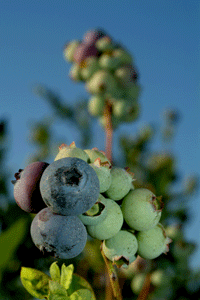November 29, 2010

Getting proper potassium uptake with blueberries can be tricky. Because of the blueberry plant’s quirky nature, growers can’t rely on soil tests to get a true reading of its nutrient needs. Precise timing of the application is also necessary in order to promote good yields.
Starting about 25 years ago, growers began noticing that soil tests and leaf analysis did not necessarily match up. Gary Pavlis, Atlantic County, N.J., Extension agent says samples from 39 farms showed no correlation between soil and leaf analysis.
“We found that nutrient levels were often fine in the soil but deficient in the plants, and vice-versa. Soil analysis is close to worthless for blueberries. We knew that leaf analysis is the better way to determine the blueberry plant’s nutrient needs,” Pavlis says.
That can give more accurate readings on phosphorus and magnesium levels as well as potassium.
 “It changed how we now make recommendations. If you do soil analysis, you really have no idea what the level is. A blueberry is a different breed of cat. It has no root hairs. It requires low pH. What nutrients are taken up is strictly pH controlled, That’s why doing soil analysis doesn’t work as far as results go,” Pavlis says.
“It changed how we now make recommendations. If you do soil analysis, you really have no idea what the level is. A blueberry is a different breed of cat. It has no root hairs. It requires low pH. What nutrients are taken up is strictly pH controlled, That’s why doing soil analysis doesn’t work as far as results go,” Pavlis says.
Potassium deficiency can cut blueberry yields. Eric Hanson, Michigan State University horticulturist, says the tips of shoots dieback if potassium level is insufficient. Leaf scorching is one symptom to look for. Young leaves can also develop a chlorosis similar in appearance to that caused by iron deficiency.
The blueberry plant’s nutrient uptake is affected by many factors ranging from soil pH and weed competition to things such as drought and disease that affect root health, says Molly Shaw, regional Extension education with the South Central New York Fruit and Vegetable Program.
If soil tests show high potassium levels but tissue analysis shows the opposite, that could be because of limited root growth in clay soils or low boron levels inhibiting nutrient uptake or high soil pH, Shaw says.
“I believe leaf analysis is the best way to go with pretty much everything, whether it might be corn or soybeans or blueberries. But blueberries are more problematic than everything else. In reality, if you want to grow blueberries, wherever you are, you have to recreate New Jersey. The water table needs to be 24 inches to 30 inches down. The pH needs to be 4.5. You need well-drained sandy soils. Trying to come up with that is really tough,” Pavlis says.
Fertilizer timing is also a big issue with blueberries. Pavlis cites Michigan State University research showing that applying fertilizer in May and June is much more effective than applying it January through April.
“The January through April applications have one-tenth of the uptake as applications in May and June. Ten pounds applied in May has the same effect as 100 pounds applied in January. Where does that January through April fertilizer go? Poof! We don’t know. You cannot rely on soil analysis for this application, Tests show that if you do apply in May and June, you could increase yield 25 percent. Some growers say they increase yield 50 percent to 100 percent by the May and June fertilizer applications,” Pavlis says.
“Potassium’s number one function in the plant is water uptake. If the potassium level is not right, that’s a problem because water certainly is critical to the health of the plant. If you have the application timing right and you have the right amount of fertilizer because of tissue analysis, and you have the right pH and the right soil, then that plant is like a good old classic Corvette that’s firing on all eight cylinders rather than just seven. It’s ready to roll,” Pavlis says.
Across the continent, potassium deficiency in Oregon blueberries rarely occurs, says John Hart, Oregon Extension soil specialist. When August tissue tests show the plants need potassium, however, Oregon State University recommends banding trial applications of potassium sulfate (0-0-52) at 150 pounds per acre. The university recommends not using potassium chloride because of potential problems with salinity.
Oregon State University specialists say potassium alone can be applied either in late fall of in spring before plants bud. When nitrogen is applied with potassium and phosphorus, spring is the best time for application.
“If rainfall is short after application, irrigate,” Hart says.
You May Also Like




